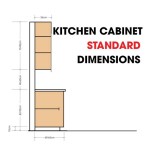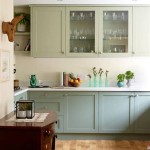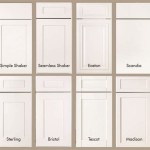Fake Greenery Above Kitchen Cabinets: Aesthetic Enhancement and Practical Considerations
The use of fake greenery atop kitchen cabinets has become increasingly popular as a method to inject visual interest and a sense of natural beauty into the kitchen space. This trend offers a versatile and low-maintenance option for homeowners seeking to enhance their kitchen's aesthetic appeal without the commitment or upkeep associated with live plants. This article explores the various aspects of incorporating fake greenery above kitchen cabinets, including the benefits, considerations, and potential drawbacks.
Aesthetic Enhancement and Visual Impact
The primary reason for using fake greenery above kitchen cabinets is to elevate the kitchen's overall aesthetic. Bare cabinet tops often present a visually empty space, which can make the kitchen feel incomplete or lacking in character. Introducing artificial plants can soften the hard lines of the cabinetry and create a more inviting and organic atmosphere. The greenery provides a visual contrast to the often-monochromatic surfaces of cabinets and countertops, adding depth and texture to the room. Different types of greenery can be chosen to complement the existing design scheme, whether it be a modern, farmhouse, or traditional style.
The visual impact of fake greenery can be further enhanced by the strategic selection of plant types and arrangement styles. Trailing plants, such as ivy or pothos, can create a cascading effect, softening the edges of the cabinets and drawing the eye upward. Bushier plants, like ferns or boxwood, can provide a fuller, more substantial visual presence. The arrangement can be tailored to suit the specific dimensions and layout of the kitchen, ensuring a balanced and harmonious look. Consider the scale of the greenery in relation to the cabinet height and the overall size of the kitchen. Too small greenery might look inconsequential, while oversized arrangements can overwhelm the space.
Furthermore, the addition of fake greenery can contribute to a sense of continuity and connection with nature. In urban environments, where access to outdoor green spaces may be limited, bringing artificial plants into the home can offer a psychological benefit, creating a more relaxing and calming environment. Even though the plants are not real, their presence can evoke a sense of freshness and vitality, enhancing the overall well-being of the occupants.
Practical Advantages and Maintenance
Beyond its aesthetic appeal, fake greenery offers several practical advantages over live plants, particularly in the context of kitchen cabinets. One of the most significant benefits is the elimination of maintenance requirements. Live plants require regular watering, fertilization, pruning, and attention to light conditions. In contrast, fake greenery requires minimal upkeep. There is no need to worry about soil moisture, nutrient deficiencies, or pest infestations. This makes it an ideal option for individuals with busy lifestyles or those who lack the time or expertise to care for live plants.
Another practical advantage of fake greenery is its durability and longevity. Unlike live plants, which have a limited lifespan and are susceptible to disease and environmental stress, artificial plants can last for many years with proper care. High-quality fake greenery is typically made from durable materials, such as plastic, silk, or polyester, which are resistant to fading, cracking, and other forms of degradation. This makes it a cost-effective option in the long run, as there is no need to replace plants regularly.
The ease of cleaning is another notable benefit of using fake greenery. Dust and debris can accumulate on the leaves of artificial plants over time, but they can be easily cleaned with a damp cloth or a vacuum cleaner with a brush attachment. For more thorough cleaning, some types of fake greenery can be gently washed with mild soap and water. This simple cleaning process helps to maintain the plant's appearance and prevent the build-up of allergens. Furthermore, fake greenery is hypoallergenic, eliminating the risk of allergic reactions associated with pollen or other plant-related allergens.
Placement of live plants above kitchen cabinets can be problematic due to the proximity to heat and steam from cooking, which can damage the plants. Fake greenery is not affected by these environmental factors, making it a more suitable option for this location. Additionally, the weight of live plants and their associated pots and soil can be a concern when placing them on top of cabinets. Fake greenery is typically much lighter, reducing the risk of damage to the cabinets or the surrounding area.
Potential Drawbacks and Considerations
Despite its many advantages, there are also potential drawbacks to consider when using fake greenery above kitchen cabinets. One of the primary concerns is the risk of dust accumulation. Cabinet tops tend to be a magnet for dust, and fake greenery can exacerbate this issue if not regularly cleaned. The intricate leaves and textures of artificial plants can trap dust particles, which can diminish their appearance and potentially contribute to indoor air pollution. Regular cleaning is essential to mitigate this issue and maintain the plant's aesthetic appeal.
Another consideration is the potential for the fake greenery to appear artificial or unnatural. Low-quality fake plants can look cheap and unconvincing, detracting from the overall aesthetic of the kitchen. It is important to invest in high-quality artificial plants that closely resemble their real counterparts. Look for plants with realistic textures, colors, and details, such as varied leaf shapes and subtle imperfections. Avoid plants with overly shiny or plastic-looking leaves, as these tend to appear less realistic.
The selection of appropriate types of fake greenery is also crucial. Certain types of artificial plants may not be suitable for the kitchen environment. For example, delicate or intricate plants may be more prone to dust accumulation and damage. It is advisable to choose plants that are durable, easy to clean, and visually appealing. Consider the overall style and color scheme of the kitchen when selecting the type of greenery. Complementary colors and textures can enhance the overall aesthetic, while clashing colors or styles can detract from it.
The arrangement of fake greenery is another important consideration. A poorly arranged display can look cluttered or haphazard, negating the desired aesthetic effect. It is important to consider the scale, shape, and color of the plants when arranging them. Experiment with different layouts and compositions until you achieve a balanced and harmonious look. Consider using different heights and textures to create visual interest. Avoid overcrowding the space, as this can make the display look cluttered and overwhelming.
Finally, it is important to be mindful of the overall context of the kitchen. Fake greenery should be used to enhance the existing design scheme, not to distract from it. Avoid using too much greenery, as this can make the kitchen feel cluttered or artificial. Consider the other elements in the kitchen, such as the cabinets, countertops, and backsplash, and choose greenery that complements these elements. A well-integrated display of fake greenery can add a touch of natural beauty to the kitchen, while an ill-conceived display can detract from its overall aesthetic.
The choice of containers or planters for the fake greenery can also impact the overall look. While the plants themselves may be artificial, using attractive pots or containers can elevate the presentation. Consider materials like terracotta, ceramic, or woven baskets that complement the kitchen's style. The size and shape of the container should be proportional to the size of the plant and the space available on top of the cabinets.
Lighting can also play a crucial role in how the fake greenery is perceived. If the area above the cabinets is dimly lit, consider adding spotlights or uplighting to highlight the plants and create a more dramatic effect. The type of lighting chosen can also influence the plant's appearance; warm lighting can enhance the greenery's natural tones, while cool lighting can create a more modern and sophisticated look.
Ultimately, the success of using fake greenery above kitchen cabinets depends on careful planning and execution. By considering the factors outlined in this article, homeowners can create a visually appealing and low-maintenance display that enhances the overall aesthetic of their kitchen space.

Decorating Above Kitchen Cabinets With Farmhouse Artificial Plants Remodel Design

Add Greenery Above Cabinets And Some Fiesta Wear Simple Decorating Kitchen Tuscan Decor

5 Kitchen Decor Items You Should Ditch Painted By Kayla Payne

Wow Me On The Weekend Decorating Above Cabinets County Road 407

Decorating Above Kitchen Cabinets Before And After Pictures Tips Joyful Daisy

Lady Goats Decorating Above Kitchen Cabinets Top

Are Fake Plants On Top Of Kitchen Cabinets Outdated

Styling Above Kitchen Cabinets 100 Things 2 Do

Fake Ivy Up Top Hooked Or It On Houses

Small Kitchen Decor
Related Posts








